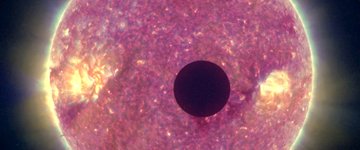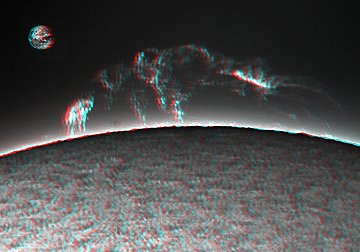 The space shuttle flies in April. Would you like a call when it soars over your backyard? Spaceweather PHONE!
The space shuttle flies in April. Would you like a call when it soars over your backyard? Spaceweather PHONE!
AURORA WATCH: Sky watchers from Scandinavia to Alaska should remain alert for auroras tonight. A solar wind stream hit Earth on March 12th, and the impact is causing high-latitude geomagnetic storms.
STEREO ECLIPSE: No human has ever witnessed a solar eclipse quite like this. NASA's STEREO-B spacecraft was about a million miles from Earth last month when it photographed the Moon passing in front of the sun:

See the movie: small, medium, large.
Talk about alien! The spacecraft recorded a fantastically-colored star wrapped around an curiously-small lunar disk. "It's like we're in the wrong solar system," says Lika Guhathakurta, STEREO Project Scientist at NASA Headquarters. Yet it really is our own sun and Moon. Find out what happened from Science@NASA.
3D PROMINENCE: Grab your 3D glasses! Astrophotographer Greg Piepol of Rockville, Maryland, has created a stereo anaglyph of this past weekend's spectacular solar prominence:

Photo details: Coronado SolarMax90, PhotoShop 3D transform filter, Callipygian 3D
Prominences are glowing clouds of hydrogen thrust up from the surface of the sun by magnetic force fields. Stereo images trace the complex threads of magnetism better than ordinary flat presentations. "Besides traditional 3D glasses, you can use red and blue astronomical filters to create the same effect," he suggests.
Updated March 11, 2007
March 3rd Lunar Eclipse Gallery
[astronomy alerts] [night-sky cameras]

